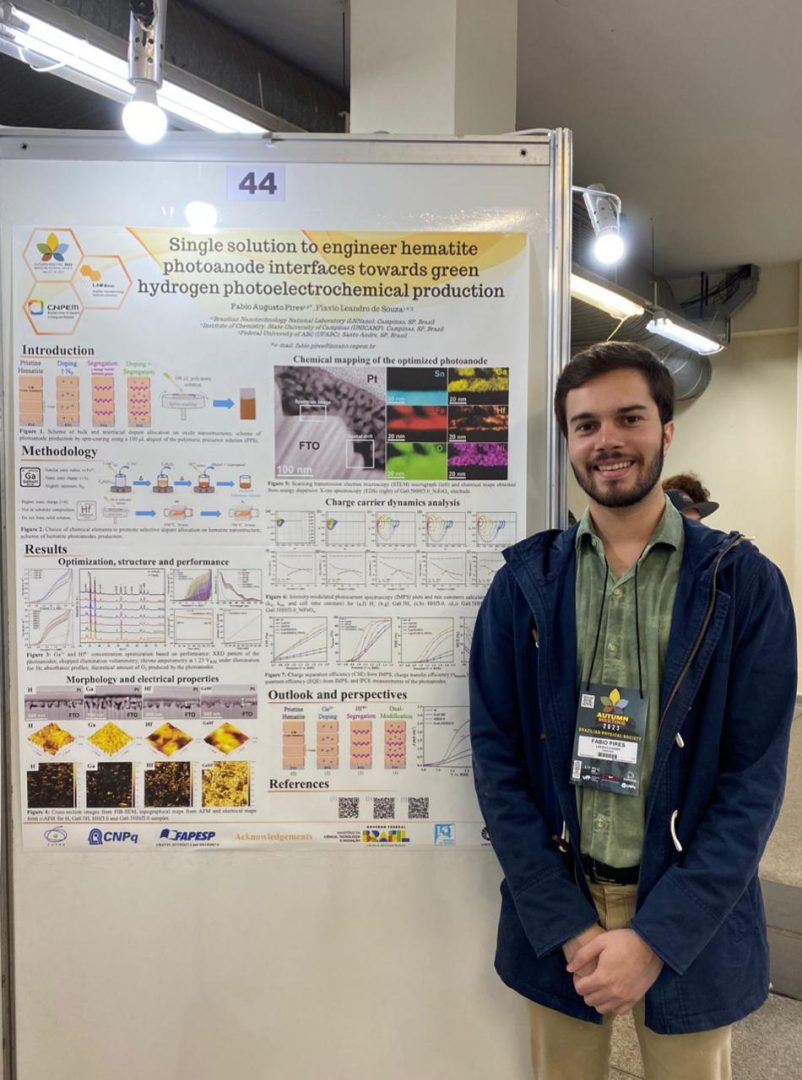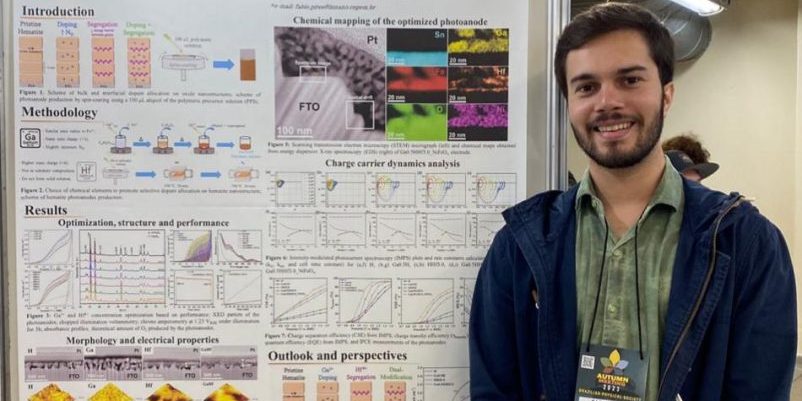The new material’s overall conversion rate for solar energy to hydrogen is 7 times higher than the previous results from the same method

Fabio Augusto Pires of the CNPEM in front of the poster from the study that was recognized at the 2023 meeting of the Brazilian Physical Society (SBF)
Electrodes made from ferrous oxides and modified with gallium and hafnium boosted the efficiency in producing clean energy by 7 times over the reference material, pure hematite. The new method also uses smaller quantities of material than previous processes, setting a new record in the area and giving the Brazilian Center for Research in Energy and Materials (CNPEM) a competitive position in the national scenario for producing prototypes.
The research that led to this discovery was presented by the CNPEM’s Fabio Augusto Pires, and was just recognized at the Fall Meeting of the Brazilian Physical Society which took place May 21–25 in Ouro Preto, Minas Gerais.
Solar energy is converted into chemical energy using photoelectrodes which can use sunlight and separate water molecules into hydrogen and oxygen. The resulting hydrogen can then be used as non-polluting fuel. Because it does not create significant environmental impacts during any stages of the process, this generation method produces what is called “green hydrogen.”
Hematite in its pure state (α-Fe2O3) is considered a stable semiconductor and is one of the most commonly used materials in photoelectrolysis of water. The problem is that most of its electronic properties limit the performance of the devices in which it is used, hindering the creation of feasible prototypes for large-scale energy conversion. This methodological hurdle has driven many researchers to look for other materials that can replace hematite.
The group of researchers at the CNPEM developed technology to produce a nanomaterial composed of one or more elements in a single stage, which allowed them to test the full versatility of this method.
Hematite modified with the simultaneous incorporation of two elements (gallium and hafnium) which carry out different functions but work in synergy led to the positive outcome. These results surpassed the previous record for performance, which was also obtained by the CNPEM using a different method involving hematite modified with germanium.
For the winner, the major innovation was actually the way of thinking about producing green hydrogen. “It is possible to transform something that is already known into something functional, instead of looking for completely different materials,” said Pires.
He added that now the next steps will involve new modifications to hematite using this method in order to find an ideal modification and later expand it to the industrial scale.
About CNPEM
A sophisticated and effervescent environment for research and development, unique in Brazil and present in few scientific centers in the world, the Brazilian Center for Research in Energy and Materials (CNPEM) is a private non-profit organization, under the supervision of the Ministry of Science, Technology and Innovation (MCTI). The Center operates four National Laboratories and is the birthplace of the most complex project in Brazilian science – Sirius – one of the most advanced synchrotron light sources in the world. CNPEM brings together highly specialized multi-thematic teams, globally competitive laboratory infrastructures open to the scientific community, strategic lines of investigation, innovative projects in partnership with the productive sector and training of researchers and students. The Center is an environment driven by the search for solutions with impact in the areas of Health, Energy and Renewable Materials, Agro-environment, and Quantum Technologies. As of 2022, with the support of the Ministry of Education (MEC), CNPEM expanded its activities with the opening of the Ilum School of Science. The interdisciplinary higher course in Science, Technology and Innovation adopts innovative proposals with the aim of offering excellent, free, full-time training with immersion in the CNPEM research environment. Through the CNPEM 360 Platform, it is possible to explore, in a virtual and immersive way, the main environments and activities of the Center, visit: https://pages.cnpem.br/cnpem360/.


